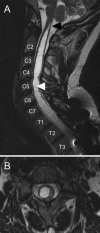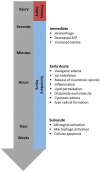Assessment and management of acute spinal cord injury: From point of injury to rehabilitation
- PMID: 28571527
- PMCID: PMC5778930
- DOI: 10.1080/10790268.2017.1329076
Assessment and management of acute spinal cord injury: From point of injury to rehabilitation
Abstract
Context: Spinal cord injury (SCI) is a devastating condition that can lead to significant neurological impairment and reduced quality of life. Despite advancements in our understanding of the pathophysiology and secondary injury mechanisms involved in SCI, there are currently very few effective treatments for this condition. The field, however, is rapidly changing as new treatments are developed and key discoveries are made.
Methods: In this review, we outline the pathophysiology, management, and long-term rehabilitation of individuals with traumatic SCI. We also provide an in-depth overview of emerging therapies along the spectrum of the translational pipeline.
Evidence synthesis: The concept of "time is spine" refers to the concept which emphasizes the importance of early transfer to specialized centers, early decompressive surgery, and early delivery of other treatments (e.g. blood pressure augmentation, methylprednisolone) to affect long-term outcomes. Another important evolution in management has been the recognition and prevention of the chronic complications of SCI including respiratory compromise, bladder dysfunction, Charcot joints, and pressure sores through directed interventions along with early integration of physical rehabilitation and mobilization. There have also been significant advances in neuroprotective and neuroregenerative strategies for SCI, many of which are actively in clinical trial including riluzole, Cethrin, stem cell transplantation, and the use of functional electrical stimulation.
Conclusion: Pharmacologic treatments, cell-based therapies, and other technology-driven interventions will likely play a combinatorial role in the evolving management of SCI as the field continues to evolve.
Keywords: Neuroprotection; Pathophysiology; Regeneration; Rehabilitation; Spinal cord injury; Stem cell; Surgical decompression; Treatment.
Figures



References
-
- Schoenfeld AJ, Laughlin MD, McCriskin BJ, Bader JO, Waterman BR, Belmont PJ Jr. Spinal injuries in United States military personnel deployed to Iraq and Afghanistan:an epidemiological investigation involving 7877 combat casualties from 2005 to 2009. Spine (Phila Pa 1976) 2013;38(20):1770–8. doi: 10.1097/BRS.0b013e31829ef226 - DOI - PubMed
Publication types
MeSH terms
Grants and funding
LinkOut - more resources
Full Text Sources
Other Literature Sources
Medical
